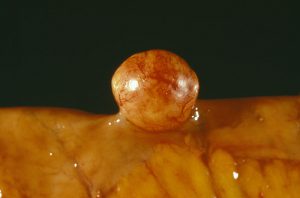Accessing the Gastrointestinal Tract

A patient with anemia underwent colonoscopy and standard upper endoscopy. Neither procedure revealed any remarkable findings. For more than 1 year, his complete blood count steadily decreased, and he began to experience fatigue. His physician ordered magnetic resonance (MR) enterography, which revealed a mass in his jejunum. He was referred to Duke for follow up.
Question: What procedure did the patient undergo that allowed Duke gastroenterologists and surgeons to visualize, mark, and remove the mass?
Daniel M. Wild, MD, gastroenterologist at Duke, explains that spiral enteroscopy enabled him to locate and tattoo a lesion in a region of the gastrointestinal tract that has historically been relatively difficult to access.
“Using spiral enteroscopy, we were able to go deep enough into the small intestine to reach the lesion seen on MR enterography,” he says. “We took a biopsy specimen and then marked it with a tattoo for the surgeon. The small bowel is about 15 feet long—it would have been a pretty difficult surgical undertaking to find the mass without the roadmap the tattoo provided.”
The mass turned out to be a large benign lipoma. Although lipomas are typically asymptomatic, it had become large enough to cause ulceration and bleeding in this patient. Once the mass was removed with laparoscopic small-bowel resection, the patient’s complete blood count and energy levels returned to normal. He has not had problems since the surgery.
“This case really highlights our approach,” Wild says. “We were able to make a diagnosis based on a symptomatic finding in an area that would have been inaccessible not too long ago. We then worked collaboratively with our surgeons who were able to perform a minimally invasive procedure to remove the mass.”
Wild adds that spiral enteroscopy allows for deep access into the small bowel as well as for full therapeutic capabilities if abnormalities are discovered. The procedure can be quickly and safely performed in outpatient facilities.